|
|
Waxy

|
|
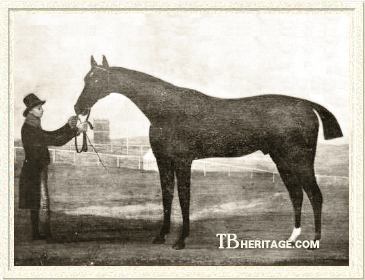 |
|
|
Epsom Derby winner Waxy was one of many horses in the last quarter of the eighteenth century with both Eclipse and Herod in his pedigeee within two generations, but he was the one that sent the Eclipse sire line forward through his Derby-winning sons WHALEBONE and WHISKER, both superior stallions and broodmare sires. Waxy's daughters were equally influential, establishing long-lived tail-female lines that still dominate the distaff side of pedigrees over 200 years after they were born.
His sire, Pot-8-Os, a chestnut son of Eclipse, was one of the best racehorses of the late eighteenth century, winner of thirty-four races during seven years on the turf, most for his breeder, Willoughby Bertie (4th) Earl Abingdon. Sold for 1,500 guineas by the financially-strapped Abingdon to Richard Grosvenor (1st) Earl Grosvenor in 1778, he ran through 1782 and was retired to Grosvenor's Oxcroft Stud in Cambridgeshire. He got 172 winners during his seventeen years at stud. In WAXY'S Derby, seven of the eleven runners were by Pot-8-Os, a measure of how dominant he was during his lifetime. But it was Waxy that far exceeded any other of his sons in the stud. Pot-8-Os also got Parasol(1800, from Prunella), an outstanding race mare, and later dam of the great sire Partisan, and of two classic winners, and Mandane, one of the most significant mares in the early nineteenth century, who produced two classic-winning daughters -- Manuella and Altisidora -- and Lottery and Brutandorf, two important stallions.
Waxy's dam, Maria (1777, by Herod), was bred by Frederick St. John, 2nd Viscount Bolingbroke, out of his mare Lisette (1772, by Snap), a winner of a sweepstakes at Newmarket at age three, her only race. Maria was sold as a yearling and ran for Charles Sulsh, winning a fifty at Doncaster over two miles, beating four, at age three, and beating the six-year-old Epsom over a mile in a 100 guineas match at Guildford. After this she was sold to Sir Ferdinando Poole (4th Baronet), of a family long-established in Cheshire, who had estates at Wirrall, Cheshire and The Friary at Lewes. Poole was engaged on the turf for most the the last quarter of the eighteenth century, and was a well-known bloodstock breeder whose horses' descendants are manifest in thoroughbred pedigrees.
For Poole, Maria went on at age four to win a fifty at Ascot, beating Ulysses, the two-mile Queen's Plate for four-year-old fillies at Chelmsford, beating five, including Oaks winner Tetotum, and at Canterbury in August won the annual subscription purse for four-year-olds over four miles, beating Fox and two others. The next season she came out three times, failing to win, and was retired to the breeding shed.
Maria produced ten foals for Poole, most of them winners, and six of them fillies. Her only foals by Pot-8-Os were Worthy (1795) and Waxy (1790). Worthy's wins included a King's Plate and the Oxford Gold Cup; he was later a modest stallion whose son, Musician, won both the Newmarket and Claret Stakes, and whose daughter, Susan, won Newmarket's July Stakes as a juvenile.
Maria's daughter, Jemima (1786, by Satellite), won five races over three seasons for Poole, including The Queen's Purse at Chelmsford, the Duke of Richmond's Purse at Lewes, and the King's Purse at Lincoln. Jemima's daughter Mother Shipton (1794, by Anvil), produced the in-bred filly MISS SHIPTON (1801, by Jemima's brother, Waxy): Her tail-female line continues to the present, with CCA Oaks winner High Schemes (1980) and Breeders' Cup Sprint winner Very Subtle (1984) recent representatives. Another Jemima daughter, Coarse Mary (1796, by Mentor), produced the in-bred IPSWICH (1804) to the cover of Waxy, a good runner whose wins included the Jockey Club Plate at Newmarket in 1794.
Maria's daughter Karen Happuch (1789, by Satellite), later purchased by Virginian William Lightfoot for export to America, also won the Jockey Club Plate for Poole. Maria's 1797 filly, Wowski (1797, by Mentor) produced the two big black brothers Thunderbolt (1806), a good juvenile that broke down early, and dual classic winner Smolensko (1810), later a sire of classic winners, both by Sorcerer. Maria died shotly after foaling Wowski in 1797.
Waxy was described as a "Very handsome rich bay, with a white stocking on the off-hind, good length, especially beautiful quarters, which he transmitted in the highest perfection to his son Whisker, who was perhaps the finer-looking of the two. Whalebone, much smaller and not so good looking as either them, barely fifteen two." In 1828 Waxy's regular exercise rider, recalling his charge, said: "Waxy was one of the finest formed horses, perfect in symmetry, beautiful in colour, admirable in all his paces, and of the finest temper, when in work; but, in the winter, after being weather-bound from frost and snow for some days, on getting out again, it was a case of 'Look out, my boys,' with a vengeance. Oft has he kicked the lappets of my coat over my head." It is unfortunate that the only accessible portrait of Waxy is a crude painting of him (above), likely a copy of an original by Francis Sartorius, which was later also engraved, and is likewise unsatisfactory.
Many famous racehorses had companion animals. Cats were popular -- with the unbeaten toast of Europe, Kincsem, with Bend Or, with Voltigeur, and others -- and Lanercost had his dog, and Dungannon his sheep. But Waxy, when at stud in his latter years, was fond of a particular rabbit. The trainer John Kent, Snr. (1783-1869), who in 1823 became a private trainer for the Duke of Richmond at Goodwood, saw Waxy in his elder years. He told his son, John Kent, Jr., who succeeded his father as a trainer for the Duke and later schooled Lord George Bentinck's runners, about the doe, who ate oats from Waxy's manger and would nestle up to him when he lay down. According to Kent, Snr., the doe made her nest in the middle of Waxy's stall, where "...family after family was reared in this risky home, and no harm ever befell one of its members from any action on the part of the horse. The old horse would thrust his nose into the nest, as though he would fondle its tiny and helpless occupants."
Waxy on the Turf
All of Poole's horses were trained by Robert Robson at Lewes. Robson's father had trained Highflyer for Lord Bolingbroke, and after serving his apprenticeship, Robson was commissioned as a private trainer by Poole. In the late 1790s Robson became a public trainer at Newmarket, where he attraced a high-class clientele, including the Duke of Grafton, the Marquis of Westminster, General Gower, Christopher Wilson, Colonel John Udney, and several others, many of which would race Waxy offspring, trained by Robson. He was among the first, if not the first, truly professional trainer, earning the sobriquet "The Emperor of Trainers," not only for the enormous number of classic winners he schooled (seven Derby winners, eleven Oaks winners, six Two Thousand Guineas winners, nine One Thousand Guineas winners, etc.), but for his influence on other trainers, dispensing with grueling trials and the tradition of schooling horses with sweats.
Robson did not believe in racing two-year-olds, and largely resisted the pressure to do so throughout his career; none of his Derby winners ran as a juvenile. Consequently Waxy came out at age three. He beat his generational rival, Gohanna, by half a length in the Epsom Derby; seven of the eleven runners in the field were by his sire, Pot-8-Os, including the third and fourth placed horses, Triptolemus and Druid. That year he also won a sweepstakes at Lewes over 1-1/2 miles, carrying seven extra pounds due to his Derby win, beating two, and a subscription sweepstakes at Abingdon, beating one.
At age four, 1794, he beat Gohanna again in the Jockey Club Plate at Newmarket Second Spring over the Round Course. The two horses were matched for 100 guineas the next day over the Beacon Course, with Waxy carrying three additional pounds, and with that slight difference, Gohanna barely beat Waxy. Poole was disinterested in match racing, but allowed his friend, the Duke of Grafton, whose horses by then were also trained by Robson, to run Waxy in his name. This was the only time Gohanna bested Waxy in the six times they met. Waxy went on to win the King's Plate at Ipswich over 2-1/4 miles, beating Robin Grey. At Lewes, he met Gohanna again for the Duke of Richmond's Plate over four miles, and beat him at even weights (9 st.-6 lbs.). Waxy also took the Ladies Plate at Lewes in a walk-over.
In 1795, age five, Waxy's only win was the King's Plate at Salisbury (four miles). He was beat by Oaks winner Hermione in the four mile Oxford Cup, with the good horse Pay or Play third, and one other in the field.
In 1796, age six, He could only place third to Viret in Newmarket's Oatlands Stakes (nine ran), and was second to Gabriel in the King's Plate. At Lewes, Waxy won the four mile subscription purse, beating two, but ran second to Guildford in the four mile Lewes Ladies Plate, which was run directly after the subscription purse. At Guildford he met Gohanna again for the four mile King's Plate, both weighted at 12 stone. In this exciting duel, Waxy won the first heat by half a head; the second was a dead-heat, and in the third Waxy again edged ahead by a half-length to win the race. The two nearly-equal horses met again in the four-mile King's Plate at Salisbury, both carrying 12 stone. For the fifth time in six encounters, Waxy won, this time in two successive heats.
The next season, 1797, Waxy broke down during the running of the Oxford Gold Cup, and was retired from the turf.
Waxy in the Stud
Waxy first went to stud at The Friary at Lewes. His initial fee was ten guineas, the same price charged for Sir Peter Teazle, Buzzard, and Pot-8-Os, but lower than the 20 guineas asked for Young Eclipse and the 12 guineas for Trumpator. By 1816, at Newmarket, his fee was 25 sovereigns.
Poole, in increasing ill-health, considered selling Waxy in the summer of 1803. Virginia horse breeder William Lightfoot, writing from England to fellow breeder John Tayloe in September of that year said, "I was at Lewes, the seat of Sir Fred. Poole, Bart. I purchased of him his favourite mare, Karen Hapuch. She is sister to Waxy and in foal to Waxy. He asked of me 700 guineas for Waxy, although he has lost an eye and is 13 years old, and I think his health is bad." There was no sale to America.
Poole died in the spring of 1804, and his successor, the Rev. Henry Poole, had no interest in horses. Some Poole stock was sold at auction at Lewes in the summer of 1804, but Robson advised Sir Henry that Waxy was too valuable to dispose of, and Waxy remained as part of the Poole estate, although he was moved to Newmarket for stud service, where he was managed by Robson. More Poole bloodstock was sold in August of 1807, but once again Waxy was retained. Later that month he was sold privately to Augustus Henry Fitzroy, the (3rd) Duke of Grafton for 300 guineas, but stayed at Newmarket for stud duty. It was in the Grafton Stud that the bulk of his significant offspring were born.
Waxy, leading sire in Great Britain in 1810, got ninety-one winners of over £70,000, among them four Derby winners -- WAXY POPE, WHALEBONE, BLUCHER, AND WHISKER (brother to Whalebone) -- and two Oaks winners, one of which also won the One Thousand Guineas. His offspring included winning precocious juveniles and outstanding four-milers, with his daughters equal to his sons on the turf, and in the stud. WHALEBONE, twice leading sire, was the son that continued the Eclipse sire line to the present, but his brother WHISKER, the sire of two classic winners, and grandsire in tail-male of Cap-a-Pie -- whose male descendants had a significant influence in Australia -- and of the great Irish racehorse Harkaway, who got the blockbuster leading sire King Tom, also had an important male influence. To a lesser extent, WOFUL (sire of four classic winners) was also a good stallion, whose distant influence comes down through his daughters. Waxy's son WAXY POPE was a leading sire nine times in Ireland and dam's sire of Bob Booty, a four-time leading sire in Ireland, both horses leaving daughters that made great contributions to the development of bloodstock in that country. Three of his sons went to France, and one, MILTON, had some influence there through a daughter.
Waxy's daughters were the dams of eight classic winners in England, and they and many other Waxy fillies established long-lived family branches that extend to the present.
Waxy's first foals, born in 1799, came to the post in 1802 as three-year-olds. They included Poole's MISS NEWLAND (1799). She was out of Jemima, a half-sister to Waxy, by Satellite. This kind of in-breeding was something Poole dabbled in several times with Waxy and Jemima, also resulting in IPSWICH and MISS SHIPTON. MISS NEWLAND won two fifties at Canterbury in her debut season. Another from this crop, SHOCK (1799, out of Slyph, by Woodpecker, from Gohanna's dam), bred and raced by George O'Brien Wyndam (3rd) Earl of Egremont, the very wealthy breeder and owner of Gohanna (and later owner of Whalebone), won a fifty at Newmarket and 100 guineas at Brighton. Although Egremont had his own breed of runners, with over seventy broodmares at his Petworth, Sussex, stud, he was not adverse to breeding his mares to outside stallions, and he and his racing confederate, the wealthy banker Robert Ladbroke (based at Headley, near Epsom), were owners and breeders of various Waxy offspring, trained by Robson at Newmarket.
Another early Waxy, ELIZABETH (1800, out of Active, by Woodpecker), was a surviving twin bred at Petworth that was sold by Ladbroke to Lord Stawell; her wins included the Chelmsford Gold Cup (two miles) in 1803.
|
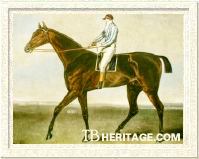
Pavilion
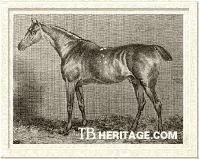
Sasenagh
| |
PAVILION and SASENAGH were other early Waxys. PAVILION (1901, out of Totterella by Dungannon) was purchased by Christopher Wilson, another associate of Egremont's, Ladbroke's, Poole's, and Grafton's, whose horses were also trained by Robson. He was then sold to William Henry Vane, (3rd) Earl of Darlington, a northern sportsman lured to and heavily invested in southern racing; Vane would purchase WHISKER in the middle of his 1816 season on the turf, and take him back to Yorkshire as a stallion.
PAVILION won the Claret Stakes at Newmarket First Spring, and at Newmarket in May won a sweepstakes over two miles beating the 1804 St. Leter winner Sancho, the 1804 Derby winner Hannibal, and Oaks winner Pelisse. Later in the year he was second in the Doncaster St. Leger. The next season he won a 2,000 guineas match against Sancho at Lewes, and in 1807 he won the Jockey Club Plate at Newmarket. PAVILION was sold to Russia as a stallion.
SASENAGH (first called IMPOSTER, 1802), out of Gohanna's dam (by Herod), who was bred to Waxy seven times, no doubt in an attempt to breed the "best to the best," was a product of Egremont's Petworth Stud, but ran for Ladbroke. While this strategy produced some winners, nothing like Gohanna or Waxy emerged from this cross. SASENAGH started first favorite for the 1805 Epsom Derby, but it was Gohanna's son, Cardinal Beaufort, that won the race. Unsuccessful in England, he was sold to Denis Bowes Daly, who took him to Ireland, where he won the Curragh's Kirwan Stakes and races at Loughrea and Eyre Court in 1806, and took three races at the Curragh in 1807, including a match against Johnny. He went to stud in Wales.
|
Waxy's son SIR WALTER RALEIGH (1801, from Woodcot, by Mentor), bred by Poole, also went to Ireland, where he got some winners, including Spider (1811), a King's Plate winner at the Curragh, and an unnamed daughter (1817) that became the dam of three good winners: Chanter (later Skeleton, 1820), Drone (1823) and Bags (1828), all grey colts by Master Robert, and all winners of the Curragh's Madrid Handicap. Drone became the leading sire in Ireland in 1834. Skeleton, a winner of five of his six starts at the Curragh for the Marquis of Sligo, was later purchased by Alexander Riley at Tattersall's, London, for £700, and sent in 1827 to Riley's Raby Park farm in New South Wales, probably the first Irish-bred horse imported into Australia. There he covered half-bred mares, usually with a lot of arabian in them, and got many winners and half-bred breeding stock that contributed to the development of the Colonial Famlies (see Colonial Family 3, for instance).
SIR WALTER RALEIGH's dam, Woodcot, that had been bred by Poole from a Herod mare, was also the dam of MISTAKE (1803), by Waxy, a filly whose tail-female descendants include the grand stayer The Hero (1843), winner of the Doncaster Cup, Ascot Gold Cup twice, Goodwood Cup and other races, and the 1902 American Champion juvenile filly, Eugenia Burch (1900, by leading sire Ben Strome), herself later dam of Belmont Stakes winner Prince Eugene (1910) and Cudgel (1914), twice American Champion Older Male.
There were other winners and some useful broodmares bred by Waxy while he was in Poole's ownership, but most were raced by others. These included DODONA (1802, from Drab, by Highflyer), bred by the Duke of Grafton, a winner of two sweepstakes at Newmarket in 1805 and 1806; NEWMARKET (1802, from a Highflyer mare), bred by Christopher Wilson, a winner of Newmarket's July Stakes as a juvenile and of other races at Newmarket in later years; the in-bred IPSWICH (1804, out of Coarse Mary, by Mentor), a winner of Newmarket's Town Plate over four miles in 1807 for Lord Jersey; ANGEOLINI (1806, from a Tandem mare), also a winner of the Town Plate at Newmarket, in 1809.
Waxy mares bred during this period included TIPPITY WITCHET (1803, from Hare, by Sweetbriar). She was second dam of three siblings that were all classic winners by Lamplighter: One Thousand Guineas winners May-Day (1831) and Firebrand (1839) and Derby winner Phosphorus (1834); a half-sibling from the same mare was Ascot Gold Cup winner Camerine (1828, by Juniper). TIPPITY WITCHET'S tail female descendants included the Grand National Steeplechase-winning sisters, Emblem (1856) and Emblematic (1858), the good Venison sons Red Deer (1841) and Red Hind (1849), and a number of other good stakes winners.
Waxy's daughter MRS. BARNET (1806, first called Taper, from a Woodpecker mare), bred by Thomas Howorth, produced Filho-da-Puta (1812, by Haphazard), whose wins included the Doncaster St. Leger, Doncaster Cup, Richmond Cup, and other good distance races and who was the leading sire in Great Britain in 1828.
Starting in 1805, after Poole's death the year before, the (3rd) Duke of Grafton made increasing use of Waxy, and in 1807 purchased him outright. When the Duke died in 1811, his son, George Henry, the 4th Duke, already deeply involved in breeding and racing, assumed ownership of the stud and racing stables, although some Grafton stock was sold at auction. Waxy was persistently bred to Grafton mares descended from Julia (1756, by Blank), purchased in 1760 by the 3rd Duke from Tommy Panton, Newmarket trainer and manager of the Royal Stables. She ran four times for Grafton, without success. In the next two generations, Julia's daughters, by Snap and Herod, and their daughters, by Eclipse, Highflyer, and Matchem -- those famous pillars of the stud book -- were building up the best thoroughbred blood. Waxy, himself basically an Eclipse-Herod cross, was a most successful match with those Grafton mares.
Prunella (1788, by Highflyer), was a grandaughter of Julia's. She ran eleven times, with "very moderate success." A foundation mare in the Grafton stud, was bred to Waxy four times, producing POPE (later called WAXY POPE), PLEDGE, POPE JOAN, AND PRUDENCE.
WAXY POPE (1806) was Waxy's first Epsom Derby winner, and was the leading sire in Ireland nine times. In the Derby he edged out the Sorcerer son, Wizard, by a neck in an exiciting race. He went on to win a sweepstakes at Ascot, and sweepstakes for 250 guineas and 450 guineas in successive days at Newmarket. He won the Lilly-Hoo Stakes and took a walk-over for a subscription purse at Newmarket October, and won the Garden Stakes at Newmarket Houghton. The following year he won a 200 guineas sweepstakes at Newmarket. He was purchased by Howe Peter Browne, (2nd) Marquess of Sligo, who inherited a fortune when he assumed the title in 1809, already a "Regency buck" who ran with the younger English aristocratic set. WAXY POPE was taken to Sligo's fabulous Westport estate in Co. Mayo, where he had an enormous influence on Irish bloodstock.
|
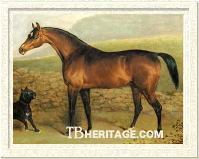
Waxy Pope from Prunella
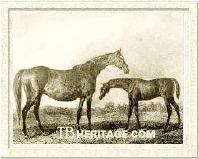
Prudence from Prunella
| |
WAXY POPE got numerous winners in Ireland, including The Dandy (1815, out of a Drone mare and so in-bred to Waxy), winner of five Royal Plates at the Curragh and Bellewstown and of the Lord Lieutenant's Plate at the Curragh and champion of his year in 1819; Prendergast (1816), whose wins included three Royal Plates at the Curragh; Starch (1819), winner of at least eight Royal Plates at the Curragh, and of the Lord Lieutenant's Plate twice, and champion in 1822; Skylark (1826), a winner of forty races, including 23 King's Plates and champion horse in Ireland three times, 1829-1831; Sligo (1821), who won the Madrid Handicap and several King's Plates at the Curragh and was champion in Ireland in 1824, and was taken to England to win Newmarket's Audley End Stakes and Oatland Stakes and other races; Sligo's brother, Mounteagle (1827), a winner of several King's Plates and the Lord Lieutenant's Plate at the Curragh and champion in Ireland in 1832; Canteen (1821), who almost won the Doncaster St. Leger for Sligo, and later won the King's Plate at Newcastle (later sire of the grand Sir Herculesrace mare, Cruiskeen); Butterfly, a winner of the Gold Cups at both Oxford and Warwick; The Cardinal (1827), whose wins in England included the Leamington Stakes and Worcester Stakes (1-1/4 miles beating Dr. Faustus and Hedgford) at Warwick, and the 2-1/2 mile Chester Cup; Trumpeter (1824) who took Newmarket's Clearwell Stakes and Cheltenham's 2-1/2 mile Glocestershire Stakes, and his sister, Jenny Vertpre (1827), a winner of Epsom's Shirley Stakes. |
WAXY POPE'S sons were not a patch on him as stallions, although a number of them went to stud in both England and Ireland. His daughters, however produced many winners, and one, The Huntsman's Mare (1816), bred Bob Booty, a winner in England, who was brought back to Ireland where he was leading sire four times, between 1825 and 1828, and also made a significant impact on Irish bloodstock through his daughters.
The Waxy-Prunella daughter PLEDGE (1807), a winner of sweepstakes at Newmarket, became the dam of the 1819 Epsom Derby winner Tiresias (1816, by Soothsayer), and two other winning colts, Welbeck (1815) and Mr. Lowe (1817). Her sister POPE JOAN (1809), winner of Royal Plates at Ipswich and Chelmsford (both two miles), among other races, produced three classic winners for the Grafton Stud -- Tontine (1822, by Election), One Thousand Guineas; Turcoman (1824, by Selim), Two Thousand Guineas; and Turquoise (1825, by Selim), Epsom Oaks. POPE JOAN'S tail-female line bred on through the twentieth century. The third Waxy-Prunella daughter, the unraced PRUDENCE (1811), bred two classic winners for Grafton, Rowena (1817, by Haphazard), winner of the One Thousand Guineas, and her brother, Reginald (1818), who won the Two Thousand Guineas. PRUDENCE'S female family continued through several branches with numerous stakes winners on every continent descending into the present.
Prunella's daughter Penelope (1798, by Trumpator) was the most significant matron at the Grafton stud, and probably holds that position in the history of the breed. She was a succesful runner between 1801, when she won her first race, a sweepstakes worth 250 guineas at Newmarket, and 1805, when she was retired to the breeding shed. Her fifteen wins included the Jockey Club Plate at Newmarket, the Oatlands Stakes (twice), and King's Plates at Ipswich and Newmarket. Covered eleven times by Waxy every year between 1805 and 1816, she produced ten foals by him, ending with the 1817 colt, WINDFALL. The influence of her Waxy sons, WHALEBONE and WHISKER, and to a lesser extent WOFUL, is manifest, but her daughters also established long-lived and ever-branching female lines that extend into the present (Family 1 - o and its branches).
|
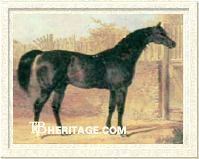
Whalebone, from Penelope
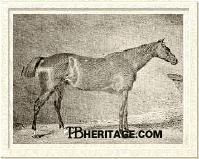
Woful, from Penelope
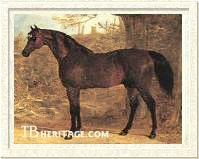
Whisker, from Penelope
| |
WHALEBONE (1807, from Penelope) established the longest-lived and most successful branch of Eclipse male descendants. Standing just over 15 hands, he was the smallest of Waxy-Penelope crosses, described as "the lowest and longest, and most double-jointed horse, with the best legs and worst feet I ever saw in my life." He was Waxy's second Epsom Derby winner, and won eleven other races, plus walk-overs, forfeits and compromises through 1813. Sold to Robert Ladbroke while still racing, he was was auctioned off in 1814 for 510 guineas to the Earl of Egremont. After a brief return to the turf, he was retired to Egremont's Petworth stud. He was the sire of two Derby-winning brothers, Lap-Dog (1823) and Spaniel (1828), and an Oaks winner, Caroline (1817), but his sons Camel (sire of Touchstone) and Sir Hercules (sire of Birdcatcher) were the ones to continue the male line. He also got Defence (1824), whose son, Ascot Gold Cup winner, The Emperor, was the probable sire of Monarque (1852), an influential sire in France, and whose daughters produced four classic winners. Several other WHALEBONE sons were sires of good racing stock and important broodmares. Some WHALEBONE daughters produced classic winners in England and France, and many of their descendants are running today.
WOFUL (1809, from Penelope), who did not run in the classics, won twelve races. Standing at Newmarket, he was utilized as a stallion by the 4th Duke of Grafton, he was the more immediately successful sire of all of the Penelope-Waxy sons. He got the winners of five classics --Arab (1824), One Thousand Guineas; Augusta (1818), Epsom Oaks; Theodore (1819), Doncaster St. Leger; and Zinc (1820), One Thousand Guineas and Epsom Oaks. He was sold to Prussia in 1832. Three of his daughters bred classic winners, and a number of his fillies established successful tail-female lines.
WHISKER (1812, from Penelope), "as near perfection in look as anything could be," was the last of Waxy's Derby winners. He won twelve races, including forfeits and compromises, through 1818.
|
WHISKER was purchased in the fall of 1816 before the Newmarket fall meetings by the Earl of Darlington (who had bought PAVILION). He was later retired to stud in Yorkshire, and his influence was at first revealed mostly in the north of England and in Ireland. He got two Doncaster St. Leger winners; one of these, The Colonel (1825) got Cap-a-Pie, who was sent to Australia where he established the dominant sire line there through his son, the Australian Sir Hercules, sire of Yattendon. Another WHISKER son, Economist, was sold to Ireland, where he got the great racehorse Harkaway, whose English-bred son, King Tom, was twice leading sire, and got some sons that were useful in the U.S. WHISKER'S daughters, some of them good stayers like their sire Whisker and his sons, were enormously influential broodmares, none more so than his fillies out of Gibside Fairy, whose descendants populate Family 7. WHISKER'S daughter Ada (1824) was sent to France, where she bred a brilliant race mare, Miss Annette and Prix du Jockey Club winner Poetess; both these mares were outstanding producers, but Poetess, as dam of Prix du Jockey Club winner Monarque, one of France's most influential sires, takes precedence. WHISKER'S daughter Delphine (1825) bred Monarch, unbeaten on the turf in the U.S., and an important stallion there.
Waxy's daughters from Penelope included WEB (1808), WILFUL (1810), and WIRE (1811). WEB, a winner, was purchased by the Earl of Jersey and was a foundation mare in his Oxfordshire stud. She produced Middleton (1822, by Phantom), a winner of the Epsom Derby, and two outstanding broodmare daughters -- Filagree (1816, by Soothsayer) and Trampoline (1825, by Tramp). Filagree was the dam of three classic winners, including Cobweb (1821), herself dam of the signficant sire and dual classic Bay Middleton, the important French sire Young Emilius, and Guineas winners Achmet and Clementina. Trampoline was the dam of Two Thousand Guineas winner Glencoe, who had an enormous influence in America through his daughters. WEB'S female line has been productive and prolific and is still going strong today.
WILFUL, who ran third in the Epsom Oaks, went to Ireland, where she produced the in-bred filly Taste (1824), by Bob Booty (out of a WAXY POPE daughter). Her female line stayed in Ireland for many years, producing winners; Oaks winner Charlebelle (1917) and other good runners descend from her.
WIRE won Newmarket's Craven Stakes and Port Stakes (beating Derby winner BLUCHER) and Royal Plates at Newmarket (two miles), Ipswich (two miles), and Canterbury (four miles) at age three. She was purchased by Col. Bruen, a relative of the Marquis of Sligo -- who had purchased WAXY POPE, and had frequently claimed one could "never have too much Waxy blood" -- for 3,000 guineas and taken to Ireland. In Ireland she was the leading money-winner of 1816, taking six races and thousands of pounds in bets. Retired to Sligo's Westport estate, she bred many winners and daughters that sent her line successfully into the present, with numerous classic winners, important broodmares and significant stallions in countries throughout the world. Her son, Verulam, was dam's sire of Partisan, and also got the Grand National Steeplechase winner Wanderer.
Penelope's dam, Prunella, had two additional daughters in the Grafton stud that were bred to Waxy: Penelope's sister, Pawn (1808, by Trumpeter), and Piquet (1810, by Sorcerer). Pawn's 1817 filly by Waxy, PAWN JUNIOR became the dam of Two Thousand Guineas winner Dervise (1823, by Merlin), and several daughters that bred on, including Delhi (1838, by Plenipotentiary), whose daughter, Ellen Horne (1844, by Redshank) is the source of Family 1-j, which branches multiple times to include numerous stakes winners, important broodmares and stallions. Piquet produced LOO (1815) another Waxy daughter that won the July Stakes and at age three sweepstakes at Newmarket. LOO's daughters also bred on, although the tail-female line ended with Grand Prix de Bruxelles winner War Dance (1887, by Galliard), a horse that was unplaced only once in 26 starts, and that later got the unbeaten juvenile Roxelane, dam of Roi Herode, and the French champion Perth, later a three-time leading sire in France.
|
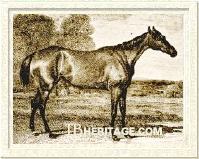
Minuet
| |
Another mare descending from Julia in the Grafton stud was Woodbine (1791, by Woodpecker), out of Julia's grandaughter, Puzzle. Waxy got two Epsom Oaks winning daughters on Woodbine: MUSIC (1810, also second in the Two Thousand Guineas) and MINUET (1812). In MUSIC'S Oaks, the first three finishers were all by Waxy: the runner-up was VULPECULA, and the third was WILFUL. MINUET won the July Stakes in her only outing as a juvenile. At age three, in addition to the Oaks, she won two sweepstakes at Newmarket, and was second in the One Thousand Guineas. She went on to win Newmarket's Trial Stakes, a 200 guineas match against Duenna, and Royal Plates at Chelmsford and Newmarket before retiring in 1817. |
MINUET bred nine sons and daughters, almost all of which were winners, but none of which went on to make a much of a mark at stud. Her son, Bolero (1822, by Partisan), became the 4th Duke of Grafton's favorite hunter and served as an improvement stallion for Grafton's tenants; his son Delapre went to Australia, where he had some importance as a stallion in south Australia.
VULPECULA (1810, from Blackberry, by Trentham) was another Grafton-bred filly by Waxy. She was sold to General Grosvenor as a yearling. In addition to her second place in the Oaks, she won a handicap sweepstakes at Newmarket at age three. She was later sold to India.
1802 Epsom Oaks winner Scotia (1799, by Delpini) was bred and raced by John Wastell, a university friend of Grafton's who later managed the Grafton stables. Scotia entered the Grafton stud as a broodmare, and produced several good foals to the cover of Waxy: JUVENAL (1807), a winner of sweepstakes at Newmarket; JOKE (1808), who took Newmarket's July Stakes as a juvenile, and JEST (1810), dam of Woodcote Stakes winner Miss Jigg (1821, by Partisan), and her sister, Ally (1818), the latter the dam of two useful stallions, Tros (1836) and Nuncio (1839).
|
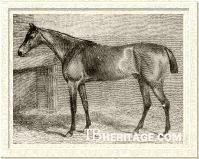
Blucher
| |
BLUCHER (1811, from Pantina, by Buzzard) was Waxy's third Epsom Derby winner. Bred and raced by Henry Stawel Bilson-Legge, (2nd) Baron Stawell, he won a 300 guineas sweepstakes and a fifty at Newmarket before his Derby triumph, when he beat Perchance, the Oatlands winner Bourbon, Wanderer, Osman, and nine others. At Egham he took the Magna Charta Stakes, easily beating his sole opponent, and at Newmarket in the fall he was third to Alcohol and the Oaks winner Medora in a sweepstakes at Newmarket. The next year he was second to WIRE in Newmarket's Port Stakes, his last race. His best runner was Palais Royale (1820), a winner of Newmarket's July Stakes. He also got some daughters that bred on in England and France, including Favourite (1821), thid dam of the dual classic winner Pretender (1866). |
BLUCHER first stood at Stawell's Marelands Stud in Surrey; he was purchased by General Grosvenor at the sale of Stawell's bloodstock after his death in 1820, and went to Grosvenor's Eaton Stud near Cheshire. He got few winners, his best probably Palais Royale (1820), a winner of Newmarket's July Stakes. He also got some daughters that bred on in England and France, including Favourite (1821), third dam of the dual classic winner Pretender (1866).
Pantina also bred OMPHALE (1812) and ANTI-GALLICAN (1817) to the cover of Waxy for Stawell. Both won several sweepstakes at Newmarket for Stawell.
|
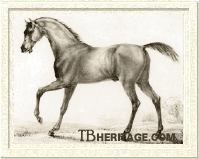
Milton
| |
MILTON (1813) was out of Miltonia, by Patriot, that was another broodmare in the Grafton stud. Running for the 4th Duke, he was a pretty good three-year-old, winning six races in 1816 at Newmarket, including three matches, and placed second to Nectar in the Newmarket St. Leger. He was sold as a stallion to the French Royal Stud, and installed at the Haras royal de Meudon. At that time French race courses and annual events were in their infancy, and the French Stud Book had yet to be established. |
MILTON got two winners of the Grand Prix at Champ-de-Mars, then run at 2-1/2 miles (the race later evolved into the Prix Gladiateur): Odysseus (1822, from Expectation) and Vittoria (1823, from Geane), both raced by AgÈnor de Gremont, the Duc de Guiche, who had a major role in establishing racing and breeding in France. Vittoria also beat Henry Seymour's English horse Link Boy, and then Two Thousand Guineas winner Turcoman (from POPE JOAN, by Waxy) in two matches over 2-1/2 miles at Champ-de-Mars.
Vittoria had an early impact on French racing as a broodmare. Her daughter, Vergogne (1846, by imp. Ibrahim), won the Prix de Diane. Son Nautilus (1835, by imp. Derby winner Cadland) won the Prix du Cadran three times, and also won the Grand Prix Royale (Grand Prix, Prix Gladiateur), and his brother, Romulus (1836) won the Prix du Jockey Club. This famous mare's daughters did not breed on, and her sons could not compete with the increasing influx of imported English stallions.
Unlike many stallions, the quality of mares sent to Waxy did not falter as he aged, and he covered several classic-winning mares in his latter years.
Waxy's daughter CORINNE (1815, from Epsom Oaks winner Briseis, by Beningbrough), was bred by General Grosvenor at his Eaton Stud in Cheshire, and sold to Colonel John Udney, for whom she won both the One Thousand Guineas and the Epsom Oaks. She went on to win a handicap subscription purse at Newmarket, and in 1820 the Gold Cup at Newmarket, and a Royal Plate at Newmarket. Her tail-female line did not breed on.
Another high-class race filly by Waxy, EMMELINE (1817), was out of the Duke of Rutland's sturdy Oaks winner Sorcery (1808 by Sorcerer), who was sent to Waxy in 1816; in 1825 Sorcery would produce the dual classic winner Cadland (by Andrew), later an important early stallion in France. EMMELINE won Newmarket's Riddlesworth Stakes at age three, and the Claret Stakes at age four. She later produced two sons, Young Phantom (1822, by Phantom), and Edmund (1824, by Orville), that got some winners.
EMMELINE'S dam Sorcery was out of Cobbea (1802, by Skyscraper), a half-sister to MRS. BARNET, by Waxy, the dam of Filho-da Puta. Sorcery's sister, Witchery (1814, by Sorcerer) produced DULCAMARA (1818) by Waxy, the last Waxy foal born. DULCAMARA was a low-level winner of two races at age three at Newmarket for E.F. Meynell. DULCAMARA produced Vestment (1831, by Longwaist, in-bred to Waxy), a winner of the Manchester Cup, and Souvenir (1824, by Orville), considered Orville's best filly on the turf. A small, stamina-laden mare, Souvenir ran for four seasons, winning eleven races, including Newmarket's Garden Stakes (beating classic winner Turcoman), the Audley End Stakes, a silver tureen at Bath, the Goodwood Stakes, and two King's Plates (one, a walk-over). She was a disappointing broodmare, but two half-sisters bred on: Salute (1829, by Muley), and Solace (1830, by Longwaist, in-bred to Waxy), with numerous stakes winners extending into the present; Salute's grandaughter, May Bell, is the taproot of Family 12-e.
Other notable Waxy winners included: CRISPIN (1807, from Tarantula, by Dragon), a winner of Newmarket's Claret Stakes at age four; JULY (1810, out of Drowsy, by Drone), who took Newmarket's July Stakes and two other races at Newmarket as a juvenile; GOLDEN-LEG (1811, from a Buzzard mare), winner of several sweepstakes at Newmarket for Lord Stawell, later died on shipboard enroute to South Africa); QUINOLA (1812, out of Black Diamond, by Stamford), a winner of the Newmarket St. Leger and two other stakes at age three; INFERIOR (1815, from Psyche, by Young Whiskey), who took three races at age three at Newmarket, including two big matches, and also won at age four, and his sister, SELINA (1814), a winner of three races at Ascot, Chelmsford and Egham; CORA (1817, from Vourneen, by Sorcerer), whose wins included Royal Plates at Lincoln and York at ages four and five.
In addition to all the classic winners out of his Grafton Stud daughters, Waxy was dam's sire of two classic winners out of his daughter, MISS WASP (1807, from Trumpetta, by Trumpator). Her dam had been sold at the dispersal of the Prince of Wales's bloodstock. MISS WASP did not do well on the turf, and was used as a saddle horse, but when the Royal Stud at Hampton Court was refurbished in 1811-12, she was bought by the stud manager and returned to Hampton Court, where she bred Manfred (1814, by Election), a winner of the Two Thousand Guineas and Newmarket's Oatlands Stakes and two other races at age three. She later also produced Oaks winner Vespa (by Muley
It is unclear how or when Waxy lost his eye, although it must have been before 1803, when he was seen by William Lightfoot. By 1808 or so, according to John Kent, Snr., he was totally blind, but through good management he lived to age 28, dying on April 10, 1818, and he had foals born that year. Ten years later his old exercise rider summarized his memoir of Waxy: "Mr Robson, who trained Waxy, tells me that a tablet is affixed to the wall under which he lies buried; but his fame will never die. So says the list of W's, the Whalebones, the Whiskers, the Wofuls, the Wires and the Webs, and now, Mr. Editor, I will dismount."
-- Patricia Erigero
|
|
|
|

